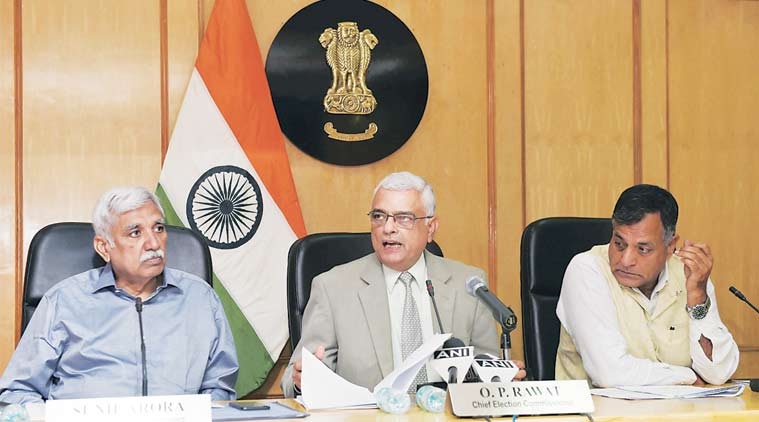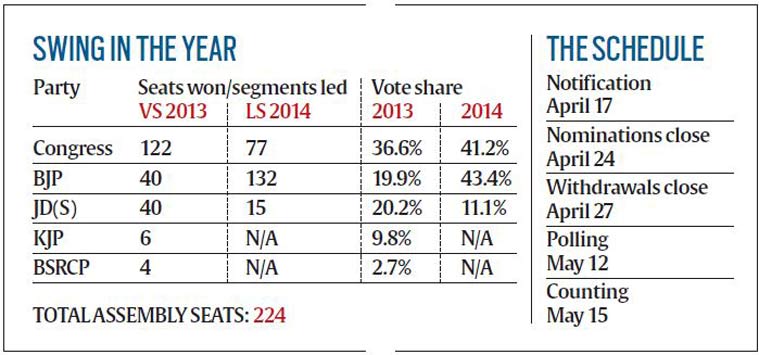Poll Season: All eyes on Karnataka, won by Congress one year, led by BJP the next
Karnataka Assembly Elections 2018: Counting of votes is on May 15. All electronic voting machines will be linked to VVPAT (voter verifiable paper audit trail).
 Chief Election Commissioner O P Rawat (centre) with Election Commissioners Ashok Lavasa and Sunil Arora at the announcement of the pol schedule. (PTI)
Chief Election Commissioner O P Rawat (centre) with Election Commissioners Ashok Lavasa and Sunil Arora at the announcement of the pol schedule. (PTI)
In Karnataka, the next state going to Assembly polls, the previous two elections threw up entirely different verdicts on the strength of the two national parties, Congress and BJP, in the state’s 224 seats. Karnataka votes on May 12, the Election Commission announced Tuesday.
Between the 2013 Assembly elections and the Lok Sabha elections, held barely a year apart, the majority at the Assembly-segment level switched from the ruling Congress to the BJP. Karnataka had bucked the trend during two previous anti-Congress electoral waves — in the 1977 and 1989 Lok Sabha elections — but followed the nationwide trend in 2014, giving the BJP 17 Lok Sabha seats to the Congress’s nine.
In terms of Assembly segments, the BJP led 132 of the 224 and the Congress 77, with the JD(S) leading the remaining 15. This was in stark contrast to the Assembly election results a year earlier, where the Congress had won 122 seats and the BJP had managed only 40, the same as the JD(S).
While the BJP’s segment leads in 2014 were more than thrice the seats won in 2013, its vote share more than doubled, from under 20% in 2013 to over 43% in 2014. Although the Congress too improved its vote share — from under 37% to over 41% — it was the steeper BJP surge, and its slightly higher vote share, that translated into larger gains.

Among the reasons for the BJP’s improved vote share, one was the return to the party of two breakaway leaders — B S Yeddyurappa and B Sriramulu, who had respectively formed the Karnataka Janata Paksha (KJP) and BSR Congress Party. After splitting from the BJP, the two parties had together taken away about 12.5% in 2013, before reuniting with the parent party.
Secondly, the JD(S) vote share almost halved from one election to the next. Having polled over 20% in 2013, it could manage only 11% in 2014.
Yeddyurappa remains central to the BJP’s strategy. He belongs to the Lingayat community, a constituency the Congress has sought to address by pushing for granting it minority religion status. The BJP, on the other hand, will bank on the projection of the Lingayat leader as its chief ministerial candidate.
The 2018 contest will be keenly watched, not only because of the extreme swing of electoral fortunes between 2013 and 2014, but also because Karnataka is the largest of the few states in which the Congress remains in power now.
The third player in Karnataka, JD(S), has already announced candidates for 126 seats. It is contesting in alliance with the BSP. Counting of votes is on May 15. All electronic voting machines will be linked to VVPAT (voter verifiable paper audit trail).
Photos



- 01
- 02
- 03
- 04
- 05



























